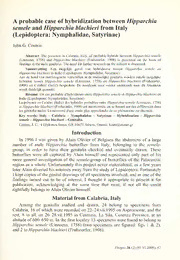
A probable case of hybridization between Hipparchia semele and Hipparchia blachieri from Italy (Lepidoptera: Nymphalidae, Satyrinae) PDF
Preview A probable case of hybridization between Hipparchia semele and Hipparchia blachieri from Italy (Lepidoptera: Nymphalidae, Satyrinae)
A probable case of hybridization between Hipparchia semele and Hipparchia blachieri from Italy (Lepidoptera: Nymphalidae, Satyrinae) John G. Coutsis Abstract. The presence in Calabria, Italy, of probable hybrids between Hipparchia semele (Linnaeus, 1758) and Hipparchia blachieri (Fruhstorfer, 1908) is presented on the basis of findings in the male genitalia. The need for further research on the subject is discussed. Samenvatting. Een mogelijk geval van hybridisatie tussen Hipparchia semele en Hipparchia blachieri in Italië (Lepidoptera: Nymphalidae, Satyrinae) Aan de hand van morfologische verschillen in de mannelijke genitalia worden enkele mogelijke hybriden tussen Hipparchia semele (Linnaeus, 1758) en Hipparchia blachieri (Fruhstorfer, 1908) uit Calabrië (Italië) besproken. De noodzaak voor verder onderzoek naar dit fenomeen wordt duidelijk gemaakt. Résumé. Un cas probable d'hybridation entre Hipparchia semele et Hipparchia blachieri en Italië (Lepidoptera: Nymphalidae, Satyrinae) La présence en Calabre (Italië) des hybrides probables entre Hipparchia semele (Linnaeus, 1758) et Hipparchia blachieri (Fruhstorfer, 1908) est mentionnée, en se basant sur des différences dans les génitalia males. La nécessité d'une étude plus approfondie de ce phénomène est discutée. Key words: Italy - Calabria - Nymphalidae - Satyrinae - Hybridization - Hipparchia semele - Hipparchia blachieri- Genitalia. Coutsis, J. G.: 4 Glykonos Street, GR-10675 Athens, Greece. [email protected] Introduction In 1996 I was given by Alain Olivier of Belgium the abdomens of a large number of male Hipparchia butterflies from Italy, belonging to the semele- group, in order to have their genitalia checked and eventually drawn. These butterflies were all captured by Alain himself and represented only part of his more general investigation of the semele-group of butterflies of the Palaearctic region as a whole. Unfortunately this project never materialized, as a few years later Alain diverted his interests away from the study ofLepidoptera. Fortunately I kept copies ofthe genital drawings of all specimens involved, and as one ofthe findings turned out to be of interest, I thought it appropriate to present it for publication, acknowledging at the same time that most, if not all the credit rightfully belongs to Alain Olivier himself. Material from Calabria, Italy Among the genitalia studied and drawn, 24 belong to specimens from Calabria, 16 of which were recorded on 22-24.vii.1995 on Aspromonte, and the rest, 8 in all, on 26-28.vii.1995 in Cerenzia, La Sila, Cosenza Province, at an altitude of 600 650 m. In the first locality 13 specimens were found to belong to & Hipparchia semele (Linnaeus, 1758) (two specimens are figured: figs 1 2), and 2 to Hipparchia blachieri (Fruhstorfer, 1908). Phegea 36 (2) (01.VI.2008): 67 Figs 1-6. Side view of left side of male genitalic armature of semele species-group taxa from Calabria, Italy; left valva omitted and aedeagus separated. 1, 2.- Hipparchia semele (Linnaeus, 1758), 20 km W of San Luca, Aspromonte, Province of Reggio, 1450-1500 m, 24.vii.1995; 3, 4- Hipparchia blachieri (Fruhstorfer, 1908); 5, 6 Probable hybrids between semele and blachieri. 3-6. Cerenzia, La Sila, Province ofCosenza, 600-650 m. 3, 4, 5. 26.vii.1995. 6. 28.vii.1995. Phegea 36 (2) (01 .VI.2008): 68 In the second locality 6 specimens were found to belong to blachieri (two & specimens are figured: figs 3 4), while 2 had genitalia that are intermediate in & characters between those ofblachieri and those ofsemele (figs 5 6), expressed by the length and, or, shape of the uncus. Differences of this kind usually are suggestive ofhybridization. Discussion This hypothesis, if eventually genetically proven, will refer to the first ever recorded case of hybridization between these two species, as well as between any two of the species belonging to the semele-group. In Greece, for instance, where the closely allied to blachieri Hipparchia senthes (Fruhstorfer, 1908), is , syntopic and synchronous both with Hipparchia volgensis (Mazochin- Porshnjakov, 1952), Hipparchia pellucida (Stauder, 1924) as well as with Hipparchia mersina (Staudinger, 1871), there is no visible sign of hybridization between the former and any single one of the others, and there certainly is no sign of hybridization between the syntopic and synchronous pellucida and mersina. This whole issue requires further investigation both quantitatively, DNA geographically, as well as through sequencing, in order to confirm hybridization, and to see whether this is but a rare exception to the rule, or whether it is a well established condition in certain localities. It certainly would also be valuable to do more thorough collecting in the areas involved here, in order to establish whether or not semele may still be present in places which the probable hybrid inhabits, and in which the latter was so far found to co-exist only with blachieri. Phegea 36 (2) (01.VI.2008): 69
